The Economics and Statistics Division maintains archives of previous publications for accountability purposes, but makes no updates to keep these documents current with the latest data revisions from Statistics Canada. As a result, information in older documents may not be accurate. Please exercise caution when referring to older documents. For the latest information and historical data, please contact the individual listed to the right.
<--- Return to Archive
For additional information relating to this article, please contact:
November 07, 2019PROVINCIAL ECONOMIC ACCOUNTS 2018 The Provincial Economic Accounts provide the official estimates of Nova Scotia's gross domestic product (GDP) and select indicators. The estimates released today include revisions for the years 2016 and 2017 and the first estimate of expenditure and income for 2018. Nova Scotia real GDP growth in 2016 and 2017 was revised up 0.1 percentage points to 1.6 per cent in both years.
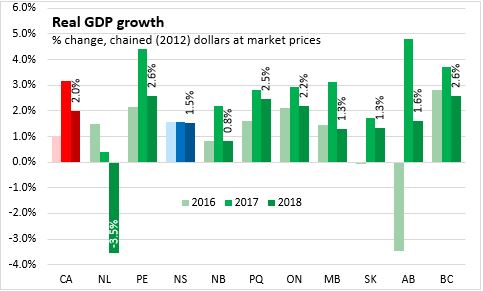
In 2018, real GDP increased 2.0 per cent in Canada with every province and territory except Newfoundland and Labrador reporting growth. Prince Edward Island and British Columbia reported the fastest growth among provinces (2.6 per cent) while Newfoundland and Labrador reported the only decline (-3.5 per cent). All provinces reported slower growth in 2018 compared to 2017. Nova Scotia real GDP grew by 1.5 per cent in 2018.
For Canada, household spending growth was 2.2 per cent in 2018. Real (adjusted for price changes) household consumption was up in all provinces in 2018. Prince Edward Island's household final consumption growth of 1.6 per cent was the largest in Atlantic Canada followed by Nova Scotia (1.2 per cent) and New Brunswick (0.8 per cent). Growth was fastest in Ontario (2.5 per cent) and in British Columbia (2.3 per cent). Government final consumption expenditures increased by 3.0 per cent nationally, with the fastest growth in Ontario (3.7 per cent) and the slowest growth in Nova Scotia (1.0 per cent).
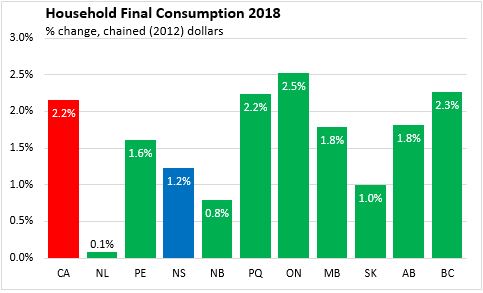
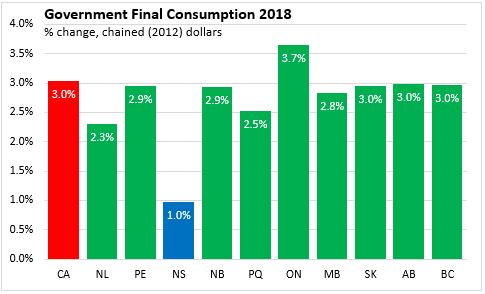
Residential expenditures were down 1.6 per cent in Canada with five provinces reporting higher expenditures compared to 2017. Prince Edward Island (6.8 per cent) and Nova Scotia (5.4 per cent) reported the fastest growth while Saskatchewan reported the largest decline (-12.4 per cent). Non-residential structures and machinery and equipment investment increased 1.4 per cent in Canada. Lower activity reported in Newfoundland and Labrador was due to completion of the Hebron oil field and Maritime Link projects. the fastest growth was in Ontario (6.3 per cent).
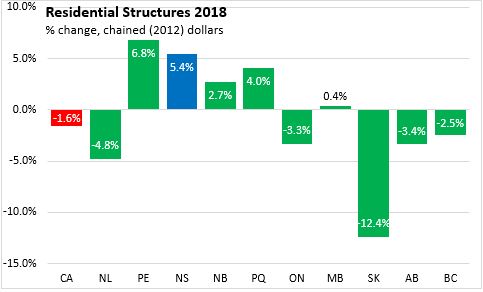
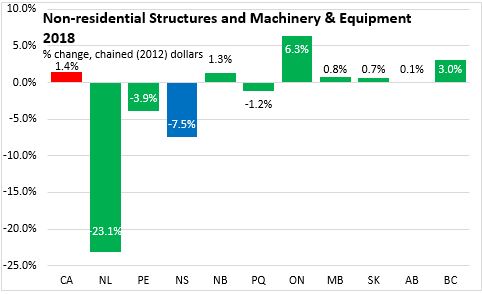
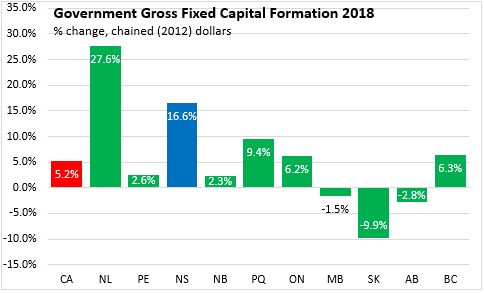
Exports of goods and services (including international and interprovincial destinations) were up in nine provinces but down in New Brunswick. Imports (international and interprovincial sources) also increased in nine provinces while declining in New Brunswick.
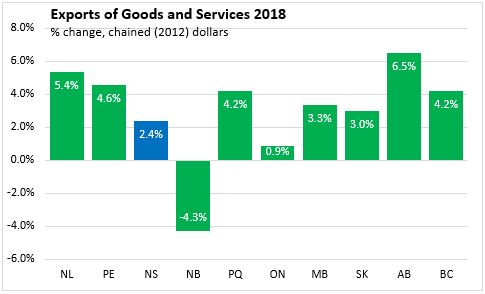
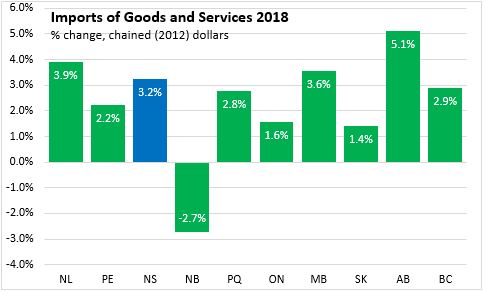
For 2018, nominal GDP (volumes and price change) grew 3.9 per cent in Canada and 3.3 per cent in Nova Scotia. Quebec (4.8 per cent) and British Columbia (4.5 per cent) reported the fastest nominal GDP growth among the provinces.
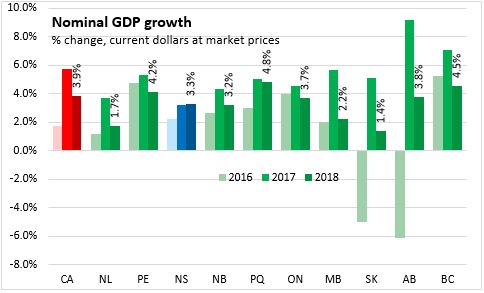
Employee compensation was up in nine provinces in 2018 and rose 4.7 per cent nationally. The fastest employee compensation growth occurred in British Columbia (5.9 per cent) followed by Ontario (5.5 per cent) and Quebec (5.3 per cent).
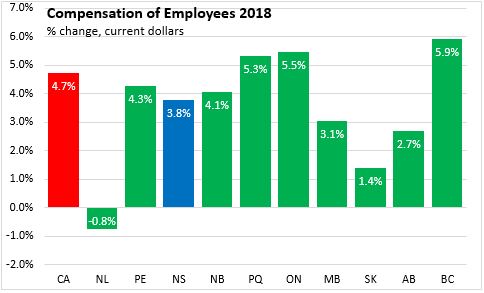
Overall household income grew by 4.3 per cent nationally with faster growth in Ontario, British Columbia and Quebec. Nova Scotia household income increased by 3.1 per cent in 2018. Only Newfoundland and Labrador experienced declining household income in 2018.
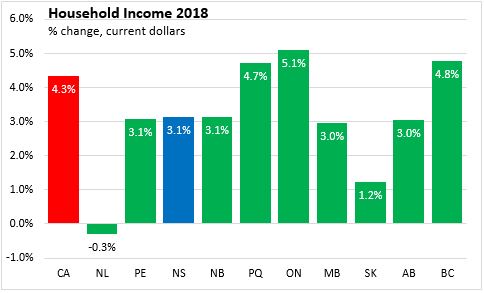
The net operating surplus of corporations increased in five provinces with an increase of 2.5 per cent in Canada. Alberta reported the fastest growth (10.3 per cent) followed by Newfoundland and Labrador (7.1 per cent).
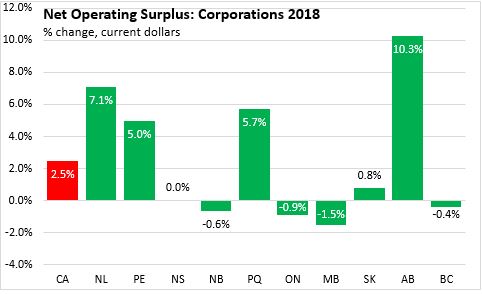
The Nova Scotia economy has grown for five consecutive years after declines in 2012 and 2013. Upward revisions for 2016 and 2017 have real GDP growing 1.6 per cent in both years. Nova Scotia’s real GDP growth continued at a similar 1.5 per cent pace in 2018.
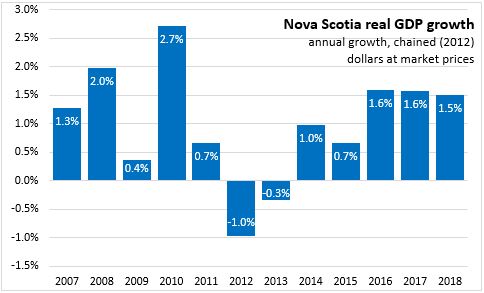
Real household consumption increased 1.2 per cent in 2018, building on the 2.9 per cent pace in 2017. Household final consumption expenditures for goods slowed to 0.4 per cent after a solid 3.9 per cent growth the previous year. Durable goods expenditures declined on lower motor vehicle purchases in 2018. Service expenditures growth continued with growth of 1.9 per cent. General government final consumption expenditures grew 1.0 per cent, the fifth consecutive year of growth. General government gross fixed capital formation grew 16.6 per cent after growth of 12.6 per cent in 2017.
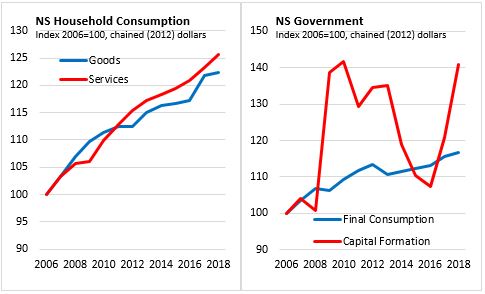
Residential structures growth continued for a fourth year with a gain of 5.4 per cent in real activity. Non-residential structures (-29.0%) declined in 2018 after four years of growth with the completion of a gold mine and the Maritime Link in 2017. Business Investment in Intellectual Property Products grew 56.4 per cent with increased oil and gas and mineral exploration activities occurring in 2018. The volume of exports was up 2.4 per cent in 2018 with higher exports of both goods and services to other countries and provinces. Imports of goods and services grew 3.2 per cent led by an increase of imported goods from other countries.
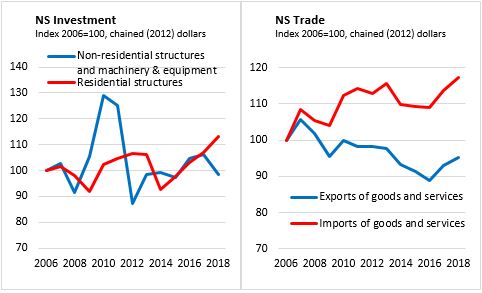
For 2018, the largest positive contributions to GDP came from increases in exports (0.89 percentage points), household consumption (0.87 percentage points), government fixed capital formation (+0.81 percentage points), and intellectual property products (0.64 percentage points). Offsetting contribution to real GDP occurred due to higher imports (-2.09 percentage points ) and non-residential structures (-1.102 percentage points) compared to 2017.

Source: Statistics Canada. Provincial and territorial economic accounts, 2018
Table 36-10-0221-01 Gross domestic product, income-based, provincial and territorial, annual (x 1,000,000)
Table 36-10-0222-01 Gross domestic product, expenditure-based, provincial and territorial, annual (x 1,000,000)
<--- Return to Archive